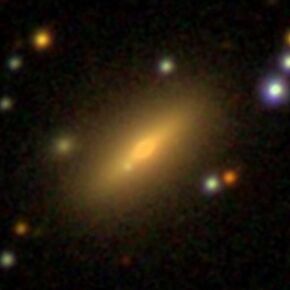Astronomy:NGC 1271
From HandWiki
Short description: Galaxy in the constellation Perseus
| NGC 1271 | |
|---|---|
 SDSS image of NGC 1271 | |
| Observation data (J2000 epoch) | |
| Constellation | Perseus |
| Right ascension | 03h 19m 11.3s[1] |
| Declination | 41° 21′ 12″[1] |
| Redshift | 0.019183[1] |
| Helio radial velocity | 5751 km/s[1] |
| Distance | 249 Mly (76.3 Mpc)[1] |
| Group or cluster | Perseus Cluster |
| Apparent magnitude (V) | 15.1[1] |
| Characteristics | |
| Type | E/SO[2] |
| Mass/Light ratio | 1.35[3] M☉/L☉ |
| Size | ~14,000 ly (4.4 kpc) (estimated)[3] |
| Apparent size (V) | 0.567 x 0.306[1] |
| Other designations | |
| CGCG 540-96, PGC 12367[1] | |
NGC 1271 is a compact elliptical or lenticular galaxy[2] located about 250 million light-years away[4] in the constellation Perseus.[5] The galaxy was discovered by astronomer Guillaume Bigourdan on November 14, 1884.[6] NGC 1271 is a member of the Perseus Cluster[7][6] and has a nuclear dust disk in its center.[3] It also has an edge-on, intermediate-scale disk and has a central bulge.[2] Like NGC 1277, NGC 1271 is a candidate "relic galaxy".[8]
Supermassive black hole
Using orbital-based stellar dynamical models, Walsh et al. determined that the supermassive black hole in the center of NGC 1271 has a mass of 3.0+1.0
−1.1×109 M☉.[3]
See also
References
- ↑ 1.0 1.1 1.2 1.3 1.4 1.5 1.6 1.7 "NASA/IPAC Extragalactic Database". Results for NGC 1271. http://nedwww.ipac.caltech.edu/.
- ↑ 2.0 2.1 2.2 Graham, Alister W.; Ciambur, Bogdan C.; Savorgnan, Giulia A. D. (2016). "Disky Elliptical Galaxies and the Allegedly Over-massive Black Hole in the Compact "ES" Galaxy NGC 1271" (in en). The Astrophysical Journal 831 (2): 132. doi:10.3847/0004-637X/831/2/132. ISSN 0004-637X. Bibcode: 2016ApJ...831..132G.
- ↑ 3.0 3.1 3.2 3.3 Walsh, Jonelle L.; Bosch, Remco C. E. van den; Gebhardt, Karl; Yildirim, Akin; Gültekin, Kayhan; Husemann, Bernd; Richstone, Douglas O. (2015-08-03). "The Black Hole in the Compact, High-Dispersion Galaxy NGC 1271" (in en). The Astrophysical Journal 808 (2): 183. doi:10.1088/0004-637X/808/2/183. ISSN 1538-4357. Bibcode: 2015ApJ...808..183W. http://adsabs.harvard.edu/cgi-bin/bib_query?arXiv:1506.05129.
- ↑ "Your NED Search Results". http://ned.ipac.caltech.edu/cgi-bin/objsearch?objname=NGC+1271&extend=no&hconst=73&omegam=0.27&omegav=0.73&corr_z=1&out_csys=Equatorial&out_equinox=J2000.0&obj_sort=RA+or+Longitude&of=pre_text&zv_breaker=30000.0&list_limit=5&img_stamp=YES.
- ↑ "Revised NGC Data for NGC 1271". http://spider.seds.org/ngc/revngcic.cgi?NGC1271.
- ↑ 6.0 6.1 "New General Catalog Objects: NGC 1250 - 1299" (in en-US). https://cseligman.com/text/atlas/ngc12a.htm#1271.
- ↑ Brunzendorf, J.; Meusinger, H. (October 1, 1999). "The galaxy cluster Abell 426 (Perseus). A catalogue of 660 galaxy positions, isophotal magnitudes and morphological types" (in en). Astronomy and Astrophysics Supplement Series 139 (1): 141–161. doi:10.1051/aas:1999111. ISSN 0365-0138. Bibcode: 1999A&AS..139..141B.
- ↑ Ferré-Mateu, Anna; Mezcua, Mar; Trujillo, Ignacio; Balcells, Marc; Bosch, Remco C. E. van den (2015). "Massive Relic Galaxies Challenge the Co-evolution of Super-massive Black Holes and Their Host Galaxies" (in en). The Astrophysical Journal 808 (1): 79. doi:10.1088/0004-637X/808/1/79. ISSN 0004-637X. Bibcode: 2015ApJ...808...79F. http://stacks.iop.org/0004-637X/808/i=1/a=79.
External links
- NGC 1271 on WikiSky: DSS2, SDSS, GALEX, IRAS, Hydrogen α, X-Ray, Astrophoto, Sky Map, Articles and images
Coordinates: ![]() 03h 19m 11.3s, 41° 21′ 12″
03h 19m 11.3s, 41° 21′ 12″
 |

